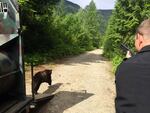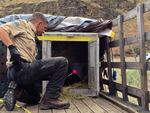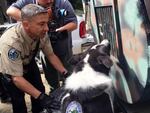
WDFW biologist Ben Maletzke helps release Cinder the Bear into the wild.
Courtney Flatt, NWPR/EarthFix
She was a year and a half old, whimpering under the shade of a horse trailer when rescuers found her.
A wildfire in North-Central Washington had been burning for a month. The young bear's paws were so badly charred that she'd been crawling on her knees and elbows. They were burned, too.
That was in 2014. The bear was a casualty of what would be known as the Carlton Complex fire. It was the biggest wildfire in Washington history.
One year later, the bear, who would be given the name Cinder, has become a symbol of the region’s recovery. On Wednesday she returned to the wild.

Rich Beausoleil helped care for Cinder the Bear the first three days after she was found.
Courtney Flatt, NWPR/EarthFix
Rich Beausoleil, the bear and cougar specialist for Washington Department of Fish and Wildlife, helped care for Cinder during the first three days after she was found.
"That was the worse case I've ever seen. You'd just go day-to-day not knowing: is she going to make it through the night? Each morning I'd wake up and that food bowl would be empty," Beausoleil said.
From there Cinder was flown to Nevada, where she spent about four months in a care facility. Then she spent about six months at Idaho Black Bear Rehab.
Up to this point, Cinder's story was not so different from that of the most famous animal to be rescued from a wildfire. But unlike Smokey Bear, Cinder isn't destined to live out her life in a zoo or as a wildfire-prevention poster bear.
Cinder and another younger bear,
, were driven this week to North Central Washington to return to the wild. The two bears bonded at the Idaho rehab, and biologists think Cinder will be able to help Kaulana out for a little while.
There was one more step before the bears could run free in the North Cascades. Biologists needed to collect information.

Rich Beausoleil tranquilizes Cinder the Bear so that they can tag and measure her.
Courtney Flatt, NWPR/EarthFix
To do that, they anesthetized Cinder with a pink tranquilizer air dart.
Cinder moaned, not too happy about it. The drugs quickly did their job. Once she was out cold two men carried her out of her cage and to a nearby clearing.
They had roughly 45 minutes until the drugs wear off.
First they inspected her healed wounds.

Biologists inspect Cinder the Bear's healed wounds.
Courtney Flatt, NWPR/EarthFix
“This is great. This is remarkable,” said Randy Hein, a veterinarian who helped care for Cinder when she was first found.
Next WDFW biologist Ben Maletzke fitted her with a GPS collar. He slid it over her neck to check the size.
“I’m gonna just make it one tighter,” Maletzke said as he screwed the collar on. The collar has a cotton spacer that will rot off in about two years, in case the tracking device doesn’t work.

Ben Maletzke fits Cinder the Bear with a GPS collar.
Courtney Flatt, NWPR/EarthFix
Then they tagged her and tattooed her.
“I do the ear tag number on her lip so that we can identify her even if the tag falls out,” Maletzke said.
They lifted her up on a green tarp to weigh her: 124.3 pounds.
Hein lent a hand taking measurements and monitoring Cinder’s vital signs.
“I can’t describe what the paws looked like. I would have never guessed they would have grown as well as they have because they were just third degree burns, just charred. Of course bears have to be able to dig and forage. She’ll be able to do that. She’ll be just fine,” Hein said.
Hein hopes in a couple of years Cinder may have cubs.
Amy Kidwell worked with Cinder and Kaulana nearly every day at Idaho Black Bear Rehab, cleaning the cages and bringing in buckets of food, or as she calls it, working as "a glorified poop scooper."
"I always feel so bad for them on this day because: how traumatic, you know? You're in your enclosure. These people come in, tranquilize you. You're in a car going 70 miles an hour," she said.
"But I think it's so worth it because then the next day they're going to open up that culvert trap and they're going to run to freedom. Life is going to be good," Kidwell said with a smile.
On Wednesday morning it was off to a forest about 30 miles north of Leavenworth. Cinder's home forest is too badly damaged to release her there. Biologists picked this area because it's full of salmonberries and insects for the bears to eat.
For the release they used
— bred to hunt aggressive animals and trained specifically to handle bear and cougar releases. The dogs flush the animals into the forest and make sure they don't return to the wildlife handlers they've been spending time with.
It may sound stressful for the bears, but Beausoleil said it’s more like tough love.

Rich Beausoleil encourages Cash, a Karelian bear dog, to help flush Cinder the Bear out of her crate.
Courtney Flatt, NWPR/EarthFix
"We're making this last visitation with people a negative one," Beausoleil said.
With that the dogs started barking at the trap.
The biologists opened the camouflaged bear trap. Cinder ran free. The biologists fired pyrotechnics to help with the "tough love" part.
Cinder paused and looks back before running into the woods.
Beausoleil said to people in Okanogan County, Cinder is an example of the tenacity and resilience necessary to move on with life after the Carlton Complex.
"We don't know what's going to happen from here," Beausoleil said. "Anything can happen out here in the wild. It's a tough place to make a living. But we've set her up for success in this spot."
